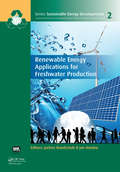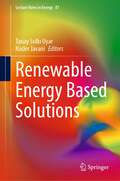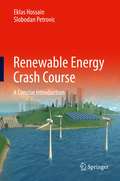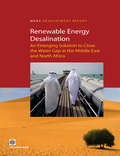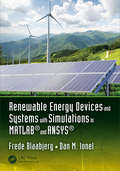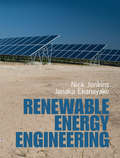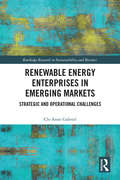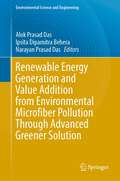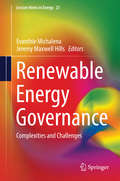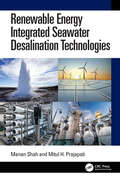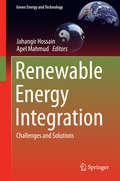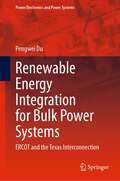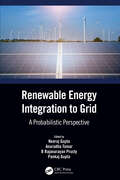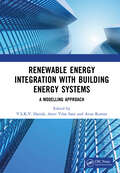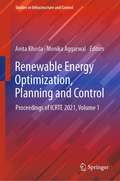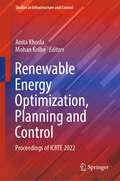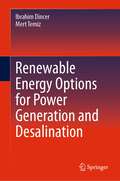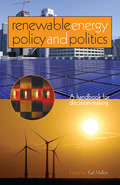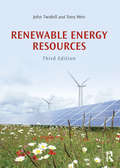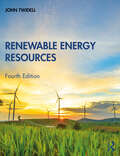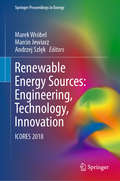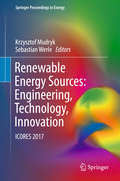- Table View
- List View
Renewable Energy - Small Hydro
by C.V.J. Varma and A.R.G. RaoThis is a collection of conference papers on small hydro renewable energy, covering such topics as: resource assessment and planning; design and construction; and plant and equipment.
Renewable Energy Applications for Freshwater Production (Sustainable Energy Developments)
by Jan Hoinkis Jochen BundschuhWorldwide, many regions have a great potential to cover part of their pressing water needs by renewable energy powered water treatment processes using either thermal or membrane based technologies. Not only arid and semiarid regions are increasingly suffering from water shortage but also many other regions face a limitation of freshwater resources either by increasing contamination of surface water bodies or groundwater resources unsuitable for drinking and irrigation purposes either due to their high grade of mineralization or their contents of toxic components. In many areas without centralized water supply, treatment techniques using locally available renewable energy resources such as wind, solar and geothermal can provide an economical, social and environmentally sustainable option for clean water production from seawater and from highly mineralized or otherwise unsuitable ground- and surface water. This book provides an overview on possible cost-efficient techniques and application opportunities for different scales and shows why the implementation of these technologies faces numerous technological, economic and policy barriers and provides suggestions how they can be overcome. It serves as a synoptic compendium of the fundamentals of freshwater production using renewable energies, applicable to all types of water, ranging from brackish to marine water and also including industrial and communal residual water. The book is aimed at professionals, academics and decision makers worldwide, working in the areas of water resources, water supply,land planning, energy planning, greenhouse gases emission mitigation and rural development.
Renewable Energy Based Solutions (Lecture Notes in Energy #87)
by Nader Javani Tanay Sıdkı UyarThis book discusses the main renewable energy resources, along with the current challenges that make it difficult achieve 100% decarbonized energy sources. It presents the perspectives of international expert authors in the field, giving readers a multi-dimensional view of the subject.The book explores numerous approaches for a smooth transition from fossil fuels to renewable energies, including those based on engineering methods, as well as policies, strategies, and social perceptions. It presents several case studies and examples from industry, showcasing the potential role of renewable sources and their challenges. The inclusion of both established methods and cutting-edge developments will make this book of interest to academics, industry professionals, policy makers, and graduate students alike.
Renewable Energy Crash Course: A Concise Introduction
by Slobodan Petrovic Eklas HossainThis book is a concise reader-friendly introductory guide to understanding renewable energy technologies. By using simplified classroom-tested methods developed while teaching the subject to engineering students, the authors explain in simple language an otherwise complex subject in terms that enable readers to gain a rapid fundamental understanding of renewable energy, including basic principles, the different types, energy storage, grid integration, and economies. This powerful tutorial is a great resource for students, engineers, technicians, analysts, investors, and other busy professionals who need to quickly acquire a solid understanding of the science of renewable energy technology.
Renewable Energy Desalination
by Bekele Debele NegewoThe Middle East and North Africa (MENA) Region is one of the most water stressed regions in the world. Water scarcity has already become a challenge to development in many of the countries. Due to increasing population and Projected climate change impacts, MENA's annual water demand gap is projected to grow five-fold by 2050, from today's 42 Km3 to 200 km3 by 2050. Despite its extreme scarcity, water is managed poorly. Inefficiencies are common in the agriculture, municipal and industrial systems; and many utilities are financially unsustainable. As a result, countries overexploit their fossil aquifers-and use desalination by fossil fuel-to meet the water demand gap. Desalination already plays a critical role in MENA's water supply portfolio. However, desalination is costly, energy intensive and has environmental impacts. On current trends, the projection is that, by 2050, Saudi Arabia and many other countries in the Region will consume for desalination most of the oil that they produce. Overexploitation of fossil aquifers is not sustainable. Neither is the use of fossil fuel for desalination to meet the growing water gap sustainable. This book outlines the challenges in terms of water (and also in terms of energy) that countries in the Region face and analyzes the scope of available options to address the growing water gap. The book estimates MENA's water gap today and into the future-until 2050; and presents a methodology to prioritize options to bridge the water gap, using the 'marginal cost of water' approach. The book also assesses the viability of renewable energy desalination as an important option to close the Region's water gap. The book compares the economic cost of desalination using fossil fuel and renewable energy sources, in particular the Concentrated Solar Power (CSP). The book also provides recommendations as to how CSP based desalination could ensure sustainable water supply for the Region.
Renewable Energy Development: Technology, Material and Sustainability (Clean Energy Production Technologies)
by Santosh Kumar Vivek Kumar SinghThis edited volume is a comprehensive guide to understanding and harnessing the power of renewable energy for a sustainable future. In a world dealing with the urgent need to combat climate change and reduce our dependence on fossil fuels, this book provides a new perspective on renewable energy. It is filled with cutting-edge research and practical insights, exploring the technologies, advanced materials, and sustainability practices driving the renewable energy revolution. Renewable energy resources are developing the latest advancements in solar, wind, hydro, geothermal, biomass, tidal, and wave energy technologies. This book is unique and opens a new window on classic renewable energy sources as well as new developments in technology, advanced material innovation, and sustainability aspects leading with various factors such as energy storage, transmission, institutional and economic factors, renewable energy application in smart cities, building and other solar thermal applications, environmental aspects, electrical energy generation, and climate change mitigation potential to achieve net-zero targets. This book is of interest to teachers, researchers, climate change scientists, capacity builders, and policymakers. Additionally, the book serves as an additional reading material for undergraduate and graduate students of sustainable energy, engineering, material science, and environmental sciences. National and international energy, sustainable and material scientists, managers, and policymakers will also find this to be a useful read.
Renewable Energy Devices and Systems with Simulations in MATLAB® and ANSYS®
by Frede Blaabjerg Dan M. IonelDue to the increasing world population, energy consumption is steadily climbing, and there is a demand to provide solutions for sustainable and renewable energy production, such as wind turbines and photovoltaics. Power electronics are being used to interface renewable sources in order to maximize the energy yield, as well as smoothly integrate them within the grid. In many cases, power electronics are able to ensure a large amount of energy saving in pumps, compressors, and ventilation systems. This book explains the operations behind different renewable generation technologies in order to better prepare the reader for practical applications. Multiple chapters are included on the state-of-the-art and possible technology developments within the next 15 years. The book provides a comprehensive overview of the current renewable energy technology in terms of system configuration, power circuit usage, and control. It contains two design examples for small wind turbine system and PV power system, respectively, which are useful for real-life installation, as well as many computer simulation models.
Renewable Energy Engineering
by Janaka Ekanayake Nick JenkinsThis book provides a quantitative yet accessible overview of renewable energy engineering practice and the technologies that will transform our energy supply system over the coming years. Covering wind, hydro, solar thermal, photovoltaic, ocean and bioenergy, the text is suitable for engineering undergraduates as well as graduate students from other numerate degrees. The technologies involved, background theory and how projects are developed, constructed, and operated are described. Worked examples of the simple techniques used to calculate the output of renewable energy schemes engage students by showing how theory relates to real applications. Tutorial chapters provide background material, supporting students from a range of disciplines and ensuring they receive the broad understanding essential for a successful career in the field. Over 150 end-of-chapter problems are included with answers to the problems available in the book and full solutions at www. cambridge. org/jenkins, password-protected for instructors.
Renewable Energy Enterprises in Emerging Markets: Strategic and Operational Challenges (Routledge Research in Sustainability and Business)
by Cle-Anne GabrielThis book highlights the challenges faced by renewable energy enterprises (REEs) in emerging markets, by reflecting on the enterprises&’ own stories and experiences. Research into REEs has focused largely on successful businesses and business models, and developed markets. With significant opportunities for renewable energy enterprise in emerging markets, this book presents a unique business-level perspective. It highlights the key barriers and outlines the strategic and operational solutions for success articulated by the entrepreneurs themselves. The research draws on interviews with entrepreneurs in twenty-eight emerging markets, including Barbados, Cambodia, Chile, Ghana, Indonesia, India, Kenya, South Africa and Uganda. The book concludes by summarising the key solutions for success and illustrating how successful REEs put them into practice. This book will be of great interest to students and scholars of renewable energy, sustainable business and the sustainability agenda in emerging markets.
Renewable Energy Generation and Value Addition from Environmental Microfiber Pollution Through Advanced Greener Solution (Environmental Science and Engineering)
by Alok Prasad Das Ipsita Dipamitra Behera Narayan Prasad DasThe majority of clothes we use regularly are made up of plastic-based materials like polyester, rayon, nylon, and acrylic. When these garments are washed in laundries, they give out tiny plastic fragments termed microfibers which end up in the environment and more precisely in the oceans. Plastic and synthetic polymer wastes which are often irresponsibly discarded into natural habitats undergo bio-fragmentation to give out huge amounts of microplastics and microfibers. Synthetic microfiber pollution has been reported in diverse ecosystems ranging from land and aquatic ecosystem to shorelines and seafloors. Due to the miniature size of the microfibers, it is difficult to detect, investigate, and prevent this type of pollution that is occurring on a larger scale. It is estimated that millions of tons of microfibers are released into the ocean from various sources. They are more toxic because they are more persistent and take a long time to degrade, and it gets accumulated in the environment along with other pollutants. This increases the chances of living organisms in the biosphere ingesting the synthetic microfibers causing harm to the ecosystem and entering into the food chain adversely affecting human beings. It had become a great field of research because of its abundance and the challenges in the identification of synthetic and semisynthetic microfibers from the environmental samples and the time it takes to be degraded. This book focuses on renewable energy generation and value addition from environmental microfiber pollution through advanced greener solution, thus building an economic supportable society as an elementary need of developing countries.
Renewable Energy Governance
by Evanthie Michalena Jeremy Maxwell HillsThis book focuses on Renewable Energy (RE) governance - the institutions, plans, policies and stakeholders that are involved in RE implementation - and the complexities and challenges associated with this much discussed energy area. Whilst RE technologies have advanced and become cheaper, governance schemes rarely support those technologies in an efficient and cost-effective way. To illustrate the problem, global case-studies delicately demonstrate successes and failures of renewable energy governance. RE here is considered from a number of perspectives: as a regional geopolitical agent, as a tool to meet national RE targets and as a promoter of local development. The book considers daring insights on RE transitions, governmental policies as well as financial tools, such as Feed-in-Tariffs; along with their inefficiencies and costs. This comprehensive probing of RE concludes with a treatment of what we call the "Mega-What" question - who is benefitting the most from RE and how society can get the best deal? After reading this book, the reader will have been in contact with all aspects of RE governance and be closer to the pulse of RE mechanisms. The reader should also be able to contribute more critically to the dialogue about RE rather than just reinforce the well-worn adage that "RE is a good thing to happen".
Renewable Energy Integrated Seawater Desalination Technologies
by Manan Shah Mitul H. PrajapatiThis book bridges the gap between conventional processes and renewable energy procedures by offering a comprehensive introduction to seawater desalination technologies.With a special focus on water quality, plant design, and the health and environmental impacts of desalination, it provides innovative solutions to optimize facilities for better accessibility to desalinated water. The first part provides a technical overview of seawater quality and desalination procedures, including thermal desalination, membrane desalination, and alternative processes like desalination batteries and capacitive deionization. The second part introduces novel freshwater production technologies using renewable energy, such as solar, wind, and geothermal desalination. With fresh insights from experts in the field, the book's value lies in providing valuable, accessible, and up-to-date knowledge about desalination to readers.This text will be of significant interest to professionals in water resource management, and academic researchers in desalination technology and environmental engineering.
Renewable Energy Integration
by Jahangir Hossain Apel MahmudThis book presents different aspects of renewable energy integration, from the latest developments in renewable energy technologies to the currently growing smart grids. The importance of different renewable energy sources is discussed, in order to identify the advantages and challenges for each technology. The rules of connecting the renewable energy sources have also been covered along with practical examples. Since solar and wind energy are the most popular forms of renewable energy sources, this book provides the challenges of integrating these renewable generators along with some innovative solutions. As the complexity of power system operation has been raised due to the renewable energy integration, this book also includes some analysis to investigate the characteristics of power systems in a smarter way. This book is intended for those working in the area of renewable energy integration in distribution networks.
Renewable Energy Integration for Bulk Power Systems: ERCOT and the Texas Interconnection (Power Electronics and Power Systems)
by Pengwei DuRenewable Energy Integration for Bulk Power Systems: ERCOT and the Texas Interconnection looks at the practices and changes introduced in the Texas electric grid to facilitate renewable energy integration. It offers an informed perspective on solutions that have been successfully demonstrated, tested, and validated by the Electric Reliability Council of Texas (ERCOT) to meet the key challenges which engineers face in integrating increased levels of renewable resources into existing electric grids while maintaining reliability. Coverage includes renewable forecasting, ancillary services, and grid and market operations. Proved methods and their particular use scenarios, including wind, solar, and other resources like batteries and demand response, are also covered. The book focuses on a real-world context that will help practicing engineers, utility providers, and researchers understand the practical considerations for developing renewable integration solutions and inspire the future development of more innovative strategies and theoretical underpinnings.
Renewable Energy Integration to the Grid: A Probabilistic Perspective
by Neeraj GuptaThis comprehensive reference text discusses uncertainty modeling of renewable energy resources and its steady state analysis. The text discusses challenges related to renewable energy integration to the grid, techniques to mitigate these challenges, problems associated with integration at transmission and distribution voltage level, and protection of power system with large renewable power integration. It covers important concepts including voltage issues in power networks, use of FACTS devices for reactive power management, stochastic optimization, robust optimization, and spatiotemporal dependence modeling. Key Features: Presents analysis and modeling of renewable generation uncertainty for planning and operation, beneficial for industry professionals and researchers. Discusses dependence modeling of multi-site renewable generations in detail. Covers probabilistic analysis, useful for data analysts. Discusses various aspects of renewable energy integration i.e. technical, economic, etc. Covers correlation factors, and methodologies are validated with case studies with various standard test systems. The text will be useful for graduate students and professionals in the fields of electrical engineering, electronics and communication engineering, renewable energy, and clean technologies.
Renewable Energy Integration with Building Energy Systems: A Modelling Approach
by Harish, V.S.K.V.Construction as an industry sector is responsible for around one-third of the total world-wide energy usage, and about 20% of greenhouse gas emissions. The rise in number of buildings and floor space area for both residential and commercial purposes has imposed enormous pressure on existing sources of energy. Implementations like efficient usage of building energy systems, design measures, utilization of local energy resources, energy storage and renewable energy sources for meeting electricity demand are currently under development and deployment to improve the energy performance index. However, integrating all such measures and evaluation of developed nearly zero-energy and zero-emission buildings is yet to be explored. In this book, different control techniques together with intelligent building technology used to improve the energy performance of buildings have been illustrated. Every building energy control system has a two-fold objective for energy and comfort requirements to achieve a high comfort index (for thermal, visual, air quality, humidity and various plug loads) and to increase the energy performance index. The most significant aspect of the design of buildings’ energy control system is modelling. All the components, methodologies and processes involved in developing a renewable energy-driven building are covered in detail. This book is intended for graduates and professionals working towards the development of sustainable built environment using renewable energy sources.
Renewable Energy Optimization, Planning and Control: Proceedings of ICRTE 2021, Volume 1 (Studies in Infrastructure and Control)
by Anita Khosla Monika AggarwalThis book gathers selected high-quality research papers presented at International Conference on Renewable Technologies in Engineering (ICRTE 2021) organized by Manav Rachna International Institute of Research & Studies, Faridabad, Haryana, India, during 15–16 April 2021. The book includes conference papers on the theme “Computational Techniques for Renewable Energy Optimization”, which aims to bring together leading academic scientists, researchers and research scholars to exchange and share their experiences and research results on all aspects of renewable energy integration, planning, control and optimization. It also provides a premier interdisciplinary platform for researchers, practitioners and educators to present and discuss the most recent innovations, trends and concerns as well as practical challenges encountered and solutions adopted in the fields of renewable energy and resources.
Renewable Energy Optimization, Planning and Control: Proceedings of ICRTE 2022 (Studies in Infrastructure and Control)
by Mohan Kolhe Anita KhoslaThis book gathers selected high-quality research papers presented at International Conference on Renewable Technologies in Engineering (ICRTE 2022) organized by Manav Rachna International Institute of Research & Studies, Faridabad, Haryana, India, during October 7–8, 2022. The book includes conference papers on the theme ‘Computational Techniques for Renewable Energy Optimization,’ which aims to bring together leading academic scientists, researchers, and research scholars to exchange and share their experiences and research results on all aspects of renewable energy integration, planning, control, and optimization. It also provides a premier interdisciplinary platform for researchers, practitioners, and educators to present and discuss the most recent innovations, trends, and concerns as well as practical challenges encountered and solutions adopted in the fields of renewable energy and resources.
Renewable Energy Options for Power Generation and Desalination
by Ibrahim Dincer Mert TemizThis book examines simultaneous power generation and desalination driven by renewable energy systems. It covers all renewables, including solar, wind, geothermal, hydro, ocean and biomass as well as waste sources. This book also includes thermodynamic fundamentals, concepts, and system design, analysis and assessment studies, along with illustrative examples and case studies, for sustainable applications. It further provides an ample opportunity to learn more about cutting-edge technologies and newly developed systems for power generation and desalination.
Renewable Energy Policy and Politics: A handbook for decision-making
by Karl MallonUnderstanding why renewable energy policies succeed and fail is essential for a range of stakeholders in the energy and environmental sectors. Clear information on why and how to secure successful renewable energy markets is much needed. Renewable Energy Policy and Politics meets that need, bringing together the experience of world leaders in this field. The book addresses the politics of renewable energy, the key players required to drive energy reform and those likely to resist change. The interplay between government, industry and society is discussed and explained with a balanced hand, offering a rare insight into political campaigning on energy. International case studies are included, complemented by a step-by-step breakdown of the elements required to achieve legislation. This book sets out the rules of the game, the stakes and the strategies for success. It will be an invaluable tool for policy makers, energy consultants, non-governmental organizations and other professionals working in the fields of energy policy, climate change and environmental policy. Students and researchers keen to enhance their knowledge of renewable energy markets and policy development will also find this essential reading.
Renewable Energy Resources
by John Twidell Tony WeirRenewable Energy Resources is a numerate and quantitative text covering the full range of renewable energy technologies and their implementation worldwide. Energy supplies from renewables (such as from biofuels, solar heat, photovoltaics, wind, hydro, wave, tidal, geothermal, and ocean-thermal) are essential components of every nation’s energy strategy, not least because of concerns for the local and global environment, for energy security and for sustainability. Thus in the years between the first and this third edition, most renewable energy technologies have grown from fledgling impact to significant importance because they make good sense, good policy and good business. This Third Edition is extensively updated in light of these developments, while maintaining the book’s emphasis on fundamentals, complemented by analysis of applications. Renewable energy helps secure national resources, mitigates pollution and climate change, and provides cost effective services. These benefits are analysed and illustrated with case studies and worked examples. The book recognises the importance of cost effectiveness and efficiency of end-use. Each chapter begins with fundamental scientific theory, and then considers applications, environmental impact and socio-economic aspects before concluding with Quick Questions for self-revision and Set Problems. The book includes Reviews of basic theory underlying renewable energy technologies, such as electrical power, fluid dynamics, heat transfer and solid-state physics. Common symbols and cross-referencing apply throughout; essential data are tabulated in appendices. An associated eResource provides supplementary material on particular topics, plus a solutions guide to Set Problems. Renewable Energy Resources supports multi-disciplinary master degrees in science and engineering, and specialist modules in first degrees. Practising scientists and engineers who have not had a comprehensive training in renewable energy will find it a useful introductory text and a reference book.
Renewable Energy Resources
by John TwidellRenewable Energy Resources is a numerate and quantitative text. It covers the many renewables technologies implemented worldwide by harnessing sustainable resources, mitigating pollution and climate change, and providing cost effective services. This fourth edition is extensively updated by John Twidell with global developments as underpinned by fundamental analysis and illustrated by case studies and worked examples. Efficiency of end-use and cost-effectiveness is emphasized. Each chapter begins with fundamental scientific theory, and then considers applications, environmental impact and socio-economic aspects, before concluding with Quick Questions for self-revision, Problems and new Exercises. Basic theory underlying the technologies is covered in succinct Reviews of electrical power, fluid dynamics, heat transfer and solid-state physics. Common symbols and cross-referencing apply throughout; essential data are tabulated in Appendices. Renewable Energy Resources supports multidisciplinary master’s degrees in science and engineering, and specialist modules at undergraduate level. Practicing scientists and engineers will find it a useful introductory text and reference book.
Renewable Energy Resources and Conservation (Green Energy and Technology)
by Philip PongThis book offers a comprehensive overview of state-of-the-art research and development in diverse areas of renewable energy, including renewable energy storage, conservation, solar, wind, biomass, nuclear, geothermal, and renewable energy systems. It is a valuable resource for anyone interested in gaining insight into the latest advancements in renewable energy technologies and their applications. The book chapters present selected high-quality research from the 8th International Conference on Renewable Energy and Conservation (ICREC 2023) that analyze the latest trends and present case studies. Renewable Energy Resources and Conservation offers researchers, practitioners, professionals, and scientists working in renewable energy engineering a host of authoritative ideas and insights into renewable energy grid infrastructures, engineering design methods, technologies, and best practices to address industrial challenges.
Renewable Energy Sources: ICORES 2018 (Springer Proceedings in Energy)
by Marek Wróbel Marcin Jewiarz Andrzej SzlękThis book presents peer-reviewed papers based on the oral and poster presentations during the 5th International Conference on Renewable Energy Sources, which was held from June 20 to 22, 2018 in Krynica, Poland. The scope of the conference included a wide range of topics in renewable energy technology, with a major focus on biomass, solar energy and geothermal energy, but also extending to heat pumps, fuel cells, wind energy, energy storage, and the modelling and optimization of renewable energy systems. This edition of the conference had a special focus on the role of renewable energy in the reduction of air pollution in the Eastern European region.Traditionally this conference is a unique occasion for gathering Polish and international researchers’ perspectives on renewable energy sources, and furthermore of balancing them against governmental policy considerations. Accordingly, the conference offered also panels to discuss best practices and solutions with local entrepreneurs and federal government bodies. The meeting attracts not only scientist but also industry representatives as well as local and federal government personnel. In 2018, the conference was organized by the University of Agriculture in Krakow in cooperation with AGH University of Science and Technology (Krakow), University of Žilina, Silesian University of Technology, International Commission of Agricultural and Biosystems Engineering (CIGR) and Polish Society of Agricultural Engineering. Honorary auspices were given by the Ministry of Science and Higher Education Republic of Poland, Rector of the University of Agriculture in Krakow and Rector of the AGH University of Science and Technology.
Renewable Energy Sources: Icores 2017 (Springer Proceedings in Energy)
by Krzysztof Mudryk Sebastian WerleThis volume presents refereed papers based on the oral and poster presentations at the 4th International Conference on Renewable Energy Sources, which was held from June 20 to 23, 2017 in Krynica, Poland. The scope of the conference included a wide range of topics in renewable energy technology, with a major focus on biomass and solar energy, but also extending to geothermal energy, heat pumps, fuel cells, wind energy, energy storage, and the modeling and optimization of renewable energy systems. The conference had the unique goal of gathering Polish and international researchers’ perspectives on renewable energy sources, and furthermore of balancing them against governmental policy considerations. Accordingly, the conference offered not only scientific sessions but also panels to discuss best practices and solutions with local entrepreneurs and federal government bodies. The Conference was jointly organized by the University of Agriculture in Krakow, the International Commission of Agricultural and Biosystems Engineering (CIGR), the Polish Society of Agricultural Engineering, AGH University of Science and Technology (Krakow), the Polish Society for Agrophysics under the patronage of the Rector of the University of Agriculture in Krakow, and the Polish Chamber of Ecology.

